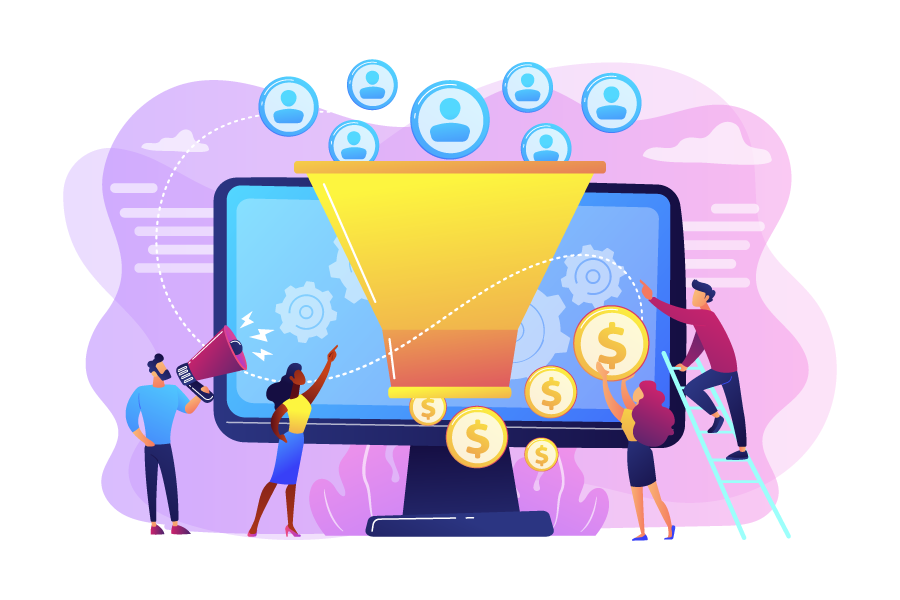Are you struggling to find tips for ecommerce lead generation for your business? Want to discover how to obtain more leads and enhance your online sales? If you’re operating an online company, ecommerce lead generation is a critical aspect of maintaining a consistent flow of money. That’s because one of the keys to obtaining more sales is to generate more leads. After all, today’s leads are tomorrow’s clients.
However, given the increased rivalry in the ecommerce industry, it’s not simple to produce leads for your website. The good news is that you can produce a regular supply of fresh leads for your ecommerce company provided you have the correct combination of ideas and tools. In this piece, we’ve compiled the best ecommerce lead generation strategies that you can implement on your website to convert it into a lead creation machine.
Ways To Generate Ecommerce Leads

1. Use Blogs To Generate Leads
You may have launched a blogging platform as an ecommerce company to improve search engine results, increase organic traffic, and foster customer loyalty. You must provide quality material on the blog page to promote sign-ups and as one of the tips for ecommerce lead generation. Today’s searchers look for answers, tasks, and ways to “do” something. Based on research:
- 84% of customers purchased things based on how they were described in blogs.
- 1 in 4 customers purchased something each month based on blog articles they read.
- 46% of customers stated they use blogs to undertake early product studies.
Blogging may be an effective tool for generating leads for ecommerce. You’re in if your blog posts “answer” the questions that customers are asking. Since they are the ones who know your clients the best, speak with your in-store sales, customer service, and sales teams. Use their ideas to create insightful blog posts. Just be careful not to sell too much on the blog. After that, you may provide them with a guide or downloaded booklet that is related to the blog post or search result.
It’s reasonable to assume that your readers have discovered the solution they were seeking if they have read at least half of the blog. This indicates that they are content or, at the very least, believe what you know. Present a newsletter opt-in form at this stage. To reassure them, emphasize that you won’t bombard their email. Visitors might also be rewarded with a minimal discount.
2. Allow Them To Register On Social Media
In a recent discussion with ecommerce firms, they discovered that a large number of customers did not complete their purchases due to the account setup process. To promote efficient ecommerce lead generation, they introduced guest checkout. As a result, the brand was unable to get any consumer information.
Turn on social account registration options like Google and Facebook in place of guest checkout. In this manner, customers may get authentic information without having to establish any passwords or fill out any forms. Additionally, because they won’t need to remember any passwords, clients will find it simple to return as registered customers. All they need to do is click to sign in.
3. Use Varied CTAs
When putting the best ecommerce lead generation strategies into practice, call-to-actions (CTAs) are frequently disregarded. If you have an “add to cart” CTA, there’s a good chance that customers will add something to their cart and then leave. Instead, try using CTAs that collect email addresses. Here are some CTAs that are tailored for ecommerce lead generation:
On the homepage:
- Join our mailing community (helps to create an email list).
- Build your registry (target a different purchasing demographic).
On the Product Page:
- Pre-order or Reserve the Product: A call-to-action (CTA) that encourages customers to secure their purchase ahead of time. This not only boosts early interest but also helps build a valuable email list before the official release of the product.
- In-Store Pick-Up or Reservation: This CTA prompts customers to choose in-store pick-up or reserve the product for collection. It’s a great way to capture important customer details, including email addresses and location, while offering convenience.
- Product Match Quiz: Engage customers with a fun quiz designed to find their perfect product match. This not only enhances their shopping experience but also guides them to make more informed purchasing decisions.
On the Checkout Page:
- Download a Product Care Guide: Offer customers the chance to download a helpful guide on how to care for their product. This not only collects their email addresses but also showcases the brand’s commitment to customer satisfaction and product longevity.
- Join the Loyalty Program: Encourage customers to sign up for your loyalty program, boosting their lifetime value with exclusive perks and rewards for repeat purchases.
- Log In for a Discount: Incentivize customers to log in by offering them a special discount. This keeps the average order value in check while fostering a personalized shopping experience.
- Get Alerts for Future Discounts: Give customers the option to sign up for alerts about upcoming discounts, providing them with early access and keeping them engaged with future sales opportunities.
4. Customize And Then Get Information
One of the most frequent reasons why customers leave ecommerce sites is to sign up. Consequently, gathering information from leads after tailoring your lead generation approach may be a useful tactic to boost conversions. Moreover, you will be able to establish enduring connections with prospective clients.
See how Lancôme offers a three-step survey to help you choose the best product, generate leads, and collect email addresses and consumer information. Following the completion of the information, the brand makes pertinent suggestions. By delivering the suggestions to the customer’s email address, Lancome gives them the choice to save them.
5. Make Time-Limited Offers
A product seems more appealing to us when it is nearing expiration or has a limited supply. Because of the way our minds are designed, we desire it more. Limited-time offers are thus a great way to increase lead generation and boost ecommerce sales.
Incorporating urgency and FOMO into your tips for ecommerce lead generation is a certain method to increase purchases. Limited-time offers may be used as a scarcity strategy to increase upsells and conversions.
6. Use Exit-Intent Pop-Ups Wisely
You’ve brought customers to your online store, but they’re now prepared to leave before you can use any lead generation tactics, like collecting email addresses or other information. One of the main reasons exit-intent pop-ups don’t work is because of poor targeting; if you’ve advertised a deal and it only applies to half of the people who see it, it won’t work.
Target customers based on their device, time, frequency, and other factors that determine which page they are on, how many times they’ve visited a page, or their past visits to your website. Observe how the company provides a customized touch and early access to new items. Furthermore, customers simply need to provide their email address to get an exclusive offer.
7. Show Recurring Visitors Several Marketing
When using retargeting and other ecommerce lead-generating tactics, cookies are very helpful and one of the best ecommerce lead generation strategies. Online companies may use cookies to monitor information about product searchers’ geographic location and other relevant characteristics. Cookies may help promote lead creation.
For example, you are a company that sells cosmetics, and previous customers are looking for “lip gloss under $50.” It might be a fantastic idea to display the precise item that customers have been searching for when they return to your online shop. In this case, suggest offering a sign-up discount on SPF-containing sunscreens or cosmetics. They will be more inclined to register and buy in this manner.
8. Communicate With Customers In Real Time
Shopping may be stressful for some people. Potential buyers may get quickly irritated while attempting to locate or purchase the correct product if online businesses provide a wide range of items. Furthermore, consumers were abruptly cut off from in-person purchasing during the pandemic.
As a result, there was a strong need for companies to provide individualized assistance. To help customers shop more effectively, ecommerce firms may use live chats with shopping assistants to develop lead-generating methods. Moreover, customers are less reluctant to provide their email addresses and other personal information to a human than to a computer.
9. Create A Community
There are further opportunities to improve the lead generation tactics when your brand mirrors a customer’s interest. Additionally, provide consumers a discount when they join up and recommend friends. For example, Nike has members-only exclusive stores that allow customers to customize their buying experience if you’re a sports business targeting athletes and sports fans.
Customers who sign up for a Nike membership may personalize their shoes and join an active community that includes priority access to Nike events, product recommendations, training, and discussions with actual athletes for professional advice. Establish a discussion board or online forum where customers may post queries and share their experiences. Allow customers to register as members of the community so they may get knowledge from the brand and experts.
How Do You Identify The Perfect Ecommerce Lead?
An ecommerce lead that is ready to make a purchase quickly is a golden opportunity for any business. When a lead is already primed and doesn’t require many tips for ecommerce lead generation, it’s a sign that your marketing efforts are working efficiently. Typically, generating sales involves multiple touchpoints and campaigns, including follow-up emails, ads, and promotions.
However, with these high-intent leads, you don’t need to go overboard with a barrage of emails or endless advertisements. Instead, you can focus on creating one well-targeted campaign with compelling copy that speaks directly to their interests. The power of a single, precise, and personalized campaign should not be underestimated.
Imagine you own a fashion store catering to customers between the ages of 25 and 35. You know that this demographic spends a significant amount of time on platforms like Facebook and Instagram, which you leverage to drive traffic to your website. Thanks to performance marketers’ strategies, many of these visitors find their way to your site.
Among these visitors, a specific subset stands out—those who are actively comparing items, adding products to their cart, or saving them for later. These individuals are clearly in a high-intent stage of the buying journey, showing that they are seriously considering making a purchase.
Moreover, some visitors spend even more time engaging with your content—scrolling through product images, reading reviews, and evaluating all the details. These are the people who are on the cusp of making a decision. This is where you find your ideal ecommerce lead: one who transitions from simply thinking, “I want this,” to decisively stating, “I want to buy.”
To ensure that these leads are valuable to your business, it’s important to aim for a 2:1 return ratio, meaning for every dollar you spend on acquiring these leads, you should expect at least two dollars in revenue. This ensures that your marketing efforts are not only attracting the right leads but also generating a profitable outcome.
FAQ
Q: Does B2B or B2C lead generation occur?
A: B2C lead generation serves customers and businesses by selling to customers directly. Centered on helping people. Lead generation for business-to-business (B2B) transactions: selling to businesses and other organizations committed to helping other companies.
Q: What is lead generation in ecommerce?
A: The act of creating customer interest in a product or service with the intention of converting that interest into a sale is known as lead generation. In internet marketing, this usually entails using a web form to gather a visitor’s contact details (referred to as a “lead”).
Q: Is lead generation part of CRM?
A: Using CRM software has long been one of the most common methods for sales teams to create and manage leads. It’s not simply a tool for managing current customers; it’s also vital for monitoring and nurturing prospects.







